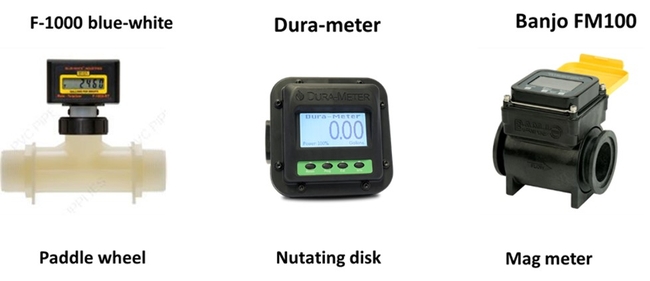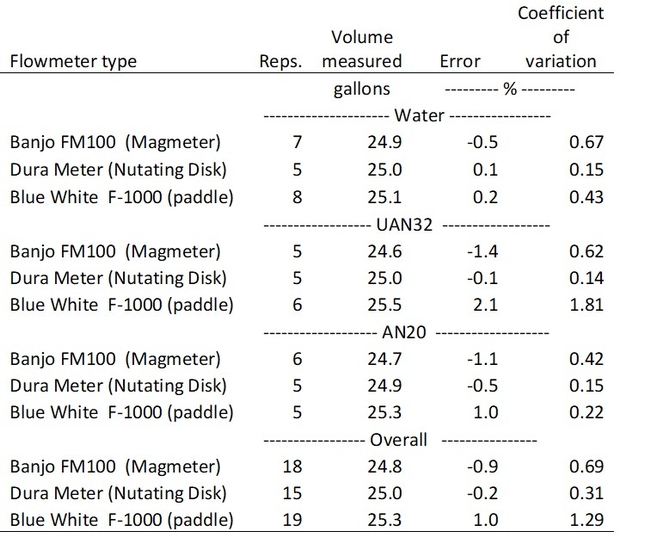Growers will need to implement best management practices that reduce nitrate leaching losses on the Central Coast to comply with Agricultural Discharge Order 4.0. The use of drip irrigation has allowed many growers to be efficient with both water and nitrogen fertilizer. Fertigating through the drip system allows for spoon feeding nitrogen in amounts matching the pattern of crop N uptake, and to place fertilizer in the root zone. Tools like the soil nitrate quick test and the online irrigation and nutrient management platform, CropManage, can help farm managers accurately determine the right amount of fertilizer to apply to satisfy crop N requirements without jeopardizing production.
Once the right amount of fertilizer to apply has been determined, it is important that irrigators have the tools that they need to accurately inject the correct volume into the drip system. Fertigation trailers usually consist of a nurse tank that can hold a maximum volume of 500 to 1000 gallons of fertilizer and are equipped with a small gas or electric pump used to inject liquid fertilizer into the drip system. Often irrigators rely on markings on the side of the nurse tank to determine the volume of fertilizer that they are injecting. These markings are usually not accurately calibrated nor have fine enough graduations to precisely measure out fertilizer volume. Furthermore, tank markings can be hard to read, especially if the trailer is not level.
A flowmeter could increase the precision of metering fertilizer into a nurse tank or for measuring the volume of fertilizer injected into the drip system. Using a flowmeter for metering fertilizer would also facilitate tracking the volume of fertilizer applied to each crop by either noting the meter readings or by interfacing the flowmeter to a datalogger that can record the application volumes.
We evaluated the accuracy of three models of flowmeters designed for metering liquid fertilizer: 1. Banjo FM100 meter, 2. Dura-meter, and 3. Blue White F-1000 (Fig. 1). Each model relies on a different mechanism to monitor fertilizer volume. The Banjo meter measures flow using a magnetic sensor, while the Dura-meter uses a nutating disk, and the Blue white meter uses a small propeller. The accuracy of the flowmeters was tested using 25 gallons of either water, ammonium nitrate (20% N), or urea-ammonium nitrate (32% N). A testing manifold was set up in the UCCE Monterey greenhouse that pumped a calibrated volume of each fluid through the flowmeters using an electric diaphragm pump. Five or more test runs were made for each meter and fluid. The average volume measured and standard deviation from the mean volume was calculated.
All three models of flowmeters accurately measured water and fertilizer volumes (Table 1). Measurement errors were generally less than ±2% of the true volume. The Dura-meter which uses a nutating disk to measure volume was the most accurate flowmeter of the three models and had an overall average absolute error of -0.2 gallons per 25 gallons measured, and a coefficient of variation of ±0.3%. The Blue White meter, which uses a paddle wheel to measure volume, was least accurate and had an overall absolute error of 1 gallon per 25 gallons measured and a coefficient of variation of ±1.3%. The type of liquid metered affected the accuracy of the Banjo and Blue White meters more than the Dura-meter.
Table 1. Accuracy of flowmeter measurements of water and two types of liquid fertilizer (AN20 and UAN32).
Although the Dura-meter was most accurate of the three flowmeters, it did require an initial calibration before testing began. The other meters could not be manually calibrated. The nutating disk mechanism directly measures volume of a liquid which may explain why the Dura-meter was not affected by the density of the liquid tested. Both the paddle wheel and the magnetic sensor mechanisms used in the Blue-White and Banjo meters indirectly estimate flow rate. Another advantage of the Dura-meter was that it was the cheapest of the three meters when the tests were conducted. Another version of the Dura-meter can be used to turn off an injection pump when a specified volume of fertilizer has been injected. This version is available as part the auto batch system (Dura-ABS™). The Banjo meter is also available in a model (MFM100) the can output an electrical pulse proportional to flow rate so that volume of fertilizer injected can be recorded on a datalogger.
Conclusions
Three commercially available flowmeters were demonstrated to accurately measure fertilizer. Either of these meters could help irrigators more precisely apply the intended volume of fertilizer to a crop as well as verify and maintain records of the fertilizer volumes used to grow each crop. Depending on the practices of the growing operation it may be more efficient to install the meters on either the nurse tank trailer or the main fertilizer tank. If the nurse tank is used for injecting fertilizer at several fields during the day, then installing the meter on the trailer would be logical, but if the nurse tank is only filled for a single field at a time, the flowmeter could be installed on the main fertilizer tank.

